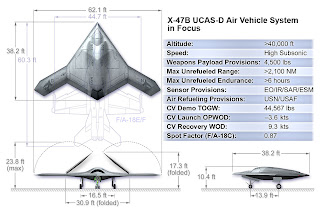The X-47B is a tailless, strike fighter-sized unmanned system currently under development by Northrop Grumman as part of the U.S. Navy’s Un...
The X-47B is a tailless, strike fighter-sized unmanned system currently under development by Northrop Grumman as part of the U.S. Navy’s Unmanned Combat Air System Demonstration (UCAS-D) program.
The X-47B is a computer-controlled unmanned aircraft system that takes off, flies a preprogrammed mission, and then returns to base – all in response to mouse clicks from a mission operator. The operator actively monitors the X-47B air vehicle's operation using simple situational awareness displays, but does not fly it via remote control, as some unmanned systems are operated.
Under a contract awarded in 2007, the company has designed, developed and is currently producing two X-47B aircraft. In the 2013 timeframe, these aircraft will be used to demonstrate the first carrier-based launches and recoveries by an autonomous, low-observable relevant unmanned aircraft. The UCAS-D program will also be used to mature relevant carrier landing and integration technologies, and to demonstrate autonomous aerial refueling by the X-47B aircraft.
UCAS-D is designed to help the U.S. Navy explore the future of unmanned carrier aviation. A successful UCAS-D flight test program, including a series of successful carrier-based launches and recoveries, will help set the stage for the development of a more permanent, carrier-based fleet of unmanned aircraft
 To date, Northrop Grumman has designed and built two tailless, fighter-sized unmanned aircraft designated the X-47B. The company will use these aircraft to demonstrate two “firsts” for unmanned jet-powered aviation: autonomous carrier operations – including launch, recovery, and deck handling – and autonomous aerial refueling using both the U.S. Air Force “boom-receptacle” and Navy “probe and drogue” methods.
To date, Northrop Grumman has designed and built two tailless, fighter-sized unmanned aircraft designated the X-47B. The company will use these aircraft to demonstrate two “firsts” for unmanned jet-powered aviation: autonomous carrier operations – including launch, recovery, and deck handling – and autonomous aerial refueling using both the U.S. Air Force “boom-receptacle” and Navy “probe and drogue” methods.While testing at Edwards Air Force base, the X-47B aircraft reached altitudes exceeding 15,000 feet and demonstrated multiple maneuvers relevant to carrier operations, including extending and retracting a tail hook, completing an autonomous"touch-and-go" landing – an aviation first – and performing landings at a high sink rate and in a heavy weight configuration.
The Northrop Grumman team is currently finalizing the software that will be required to enter carrier suitability testing of the X-47B. That testing will include catapult launches, arrested landings and wireless remote deck handling of the aircraft.
The first X-47B was moved to Patuxent River in December 2011. The testing at Pax River is scheduled to begin in early 2012. It will include testing the X-47B's ability to conduct precision approaches to the carrier, and to perform arrested landings and"roll-out" catapult launches at land-based test facilities. The testing will also include flight testing precision navigation computers and new guidance, navigation and control software recently installed on both aircraft. The new suite of hardware and software will enable the X-47B to make precision landings on a moving carrier deck.
It is currently undergoing electromagnetic interference testing, which is designed to demonstrate that the X-47B is compatible with the electromagnetic signal environment of an aircraft carrier.
In August 2007, the U.S. Navy selected Northrop Grumman as the prime contractor for the Unmanned Combat Air System Demonstration (UCAS-D) program. The program will demonstrate the first-ever carrier launches and recoveries, and autonomous aerial refueling by an autonomous, low-observable-representative unmanned aircraft












